
Phantasy Star is a role-playing video game (RPG) developed by Sega and released for the Master System in 1987. One of the earliest Japanese RPGs for consoles, Phantasy Star tells the story of Alis on her journey to defeat the evil ruler of her star system, King Lassic, after her brother dies at his hands. She traverses between planets, gathering a party of fighters and collecting the items she needs to avenge her brother's death and return peace to the star system. The gameplay features traditional Japanese RPG elements including random encounters and experience points. All the characters have predefined personalities and abilities, a unique element compared to the customizable characters of other RPGs of the era.
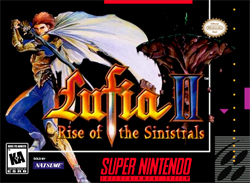
Lufia II: Rise of the Sinistrals, known as Estpolis Denki II in Japan, and as Lufia in Europe and Australia, is a role-playing video game with puzzle elements developed by Neverland and published in Japan in 1995 by Taito, and in North America and Europe in 1996 by Natsume and Nintendo respectively, for the Super Nintendo Entertainment System. It is the second game in the Lufia series.
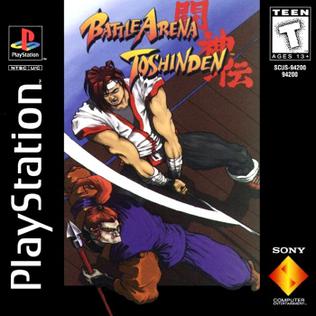
Battle Arena Toshinden is a fighting video game developed by Tamsoft and published by Takara for the PlayStation. Originally released in 1995, it was released internationally by Sony Computer Entertainment, followed by 1996 ports for the Sega Saturn, Game Boy and MS-DOS. It was one of the first fighting games, after Virtua Fighter in 1993 on arcade and console, to boast polygonal characters in a 3D environment, and features a sidestep maneuver which is credited for taking the genre into "true 3D."
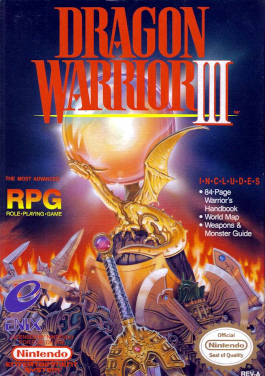
Dragon Quest III: The Seeds of Salvation, titled Dragon Warrior III when initially localized to North America, is a 1988 role-playing video game developed by Chunsoft and published by Enix. It is the third installment in the Dragon Quest series and was first released for the Family Computer (Famicom) in Japan and later for the Nintendo Entertainment System (NES) in North America. The game saw an enhanced remake for the Super Famicom in 1996 and the Game Boy Color in 2001, and a port to mobile phones and the Wii in 2009 and 2011. A version of the game for Android and iOS was released in Japan on September 25, 2014, and worldwide as Dragon Quest III: The Seeds of Salvation on December 4, 2014. It was the first time the game was given an official English subtitle. Later in 2021, another remake of the game titled Dragon Quest III HD-2D Remake, based on Octopath Traveler's style, was announced during the franchise's 35th anniversary livestream.
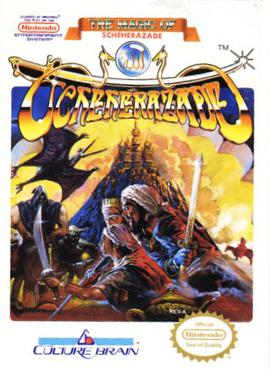
The Magic of Scheherazade is an action-adventure/role-playing video game (RPG) developed and released by Culture Brain for the Nintendo Entertainment System (NES). The game was released in 1987 in Japan and 1990 in North America. The plot is based on Middle Eastern folktales found in One Thousand and One Nights. It involves an amnesic hero traveling through time in an attempt to rescue the princess Scheherazade from the evil wizard Sabaron, who has summoned a horde of demons to bring chaos to the once peaceful land of Arabia. The Magic of Scheherazade is divided into chapters and incorporates elements of both action-adventure and RPG gameplay styles. In each chapter, the player character can freely explore an overworld in a top-down perspective. The player engages hostile enemies with various weapons and spells through both real-time solo action on the overhead map and random, turn-based battles fought alongside befriended allies.
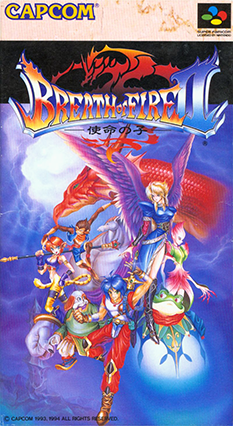
Breath of Fire II is a role-playing video game developed and published by Capcom. First released in 1994, the game was licensed to Laguna for European release in 1996. It is the second entry in the Breath of Fire series. It was later ported to Game Boy Advance and re-released worldwide. The game was released on Wii's Virtual Console in North America on August 27, 2007. Nintendo of Europe's website mistakenly announced it for release on July 27, 2007, but it was in fact released two weeks later, on August 10, 2007. In 2013, it was released for the Wii U Virtual Console. In 2016, it was released for the New Nintendo 3DS Virtual Console. In 2019, it was released for the Nintendo Switch SNES games library.
1990 saw many sequels and prequels in video games, such as Metal Gear 2: Solid Snake, Dr. Mario, Dragon Quest IV, Final Fantasy III, Phantasy Star II, and Super Mario World, along with new titles such as Fire Emblem: Shadow Dragon and the Blade of Light and Magic Sword. The year's highest-grossing arcade video games were Final Fight in Japan and Teenage Mutant Ninja Turtles in the United States. The year's best‑selling system was the Game Boy, while the year's best-selling home video game was Super Mario Bros. 3 for the Nintendo Entertainment System.
1988 saw many sequels and prequels in video games, such as Dragon Quest III, Super Contra, Super Mario Bros. 2, Mega Man 2, Double Dragon II: The Revenge, and Super Mario Bros. 3, along with new titles such as Assault, Altered Beast, Capcom Bowling, Ninja Gaiden, RoboCop, Winning Run and Chase H.Q.
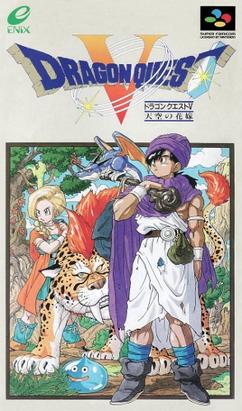
Dragon Quest V: Hand of the Heavenly Bride is a role-playing video game and the fifth installment in the Dragon Quest video game series, second of the Zenithian Trilogy. Originally developed by Chunsoft and published by Enix Corporation, Dragon Quest V was the first title in the series to be released for the Super Famicom video game console in Japan in September 1992. Dragon Quest V was the first game in the series to not be released in America due to programming issues at the time.
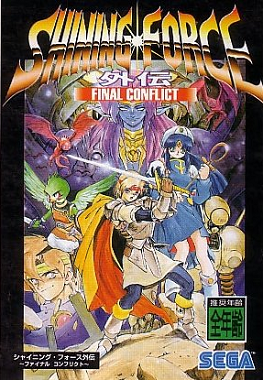
Shining Force Gaiden: Final Conflict is a 1995 tactical role-playing game for the Game Gear, taking place between the games Shining Force and Shining Force II. It was released after both games, with the intention of connecting their plots. Despite its name, it is not directly story-related to Shining Force Gaiden or Shining Force Gaiden II, also released for Game Gear. Unlike most of its predecessors, the game was never released outside Japan. English patches have been created by fans for players who cannot speak Japanese.

Raiden Project, known outside Japan as The Raiden Project, is a scrolling shooter video game developed and published by Seibu Kaihatsu for the PlayStation. It is a compilation of the arcade games Raiden (1990) and Raiden II (1993). It was released in Japan on January 27, 1995, for North America by Sony Computer Entertainment as an original launch title on September 9, 1995, and in Europe by Ocean Software in November 12, 1995. This was the only console release of Raiden II and unlike previous ports, these versions are based directly on the arcade originals. The Project version of the first Raiden was available as a download from the Japanese PlayStation Network store, which could be played on either a PlayStation 3 or a PlayStation Portable.

Mystaria: The Realms of Lore, released as Riglord Saga in Japan, is a tactical role-playing game for the Sega Saturn. In late 1996 it was re-released as Blazing Heroes in North America. Its graphics consist of pre-rendered sprites and polygonal backgrounds. Its sequel, Riglord Saga 2, was released in Japan only in 1996.

Arc the Lad is a tactical role-playing video game developed by G-Craft and published by Sony Computer Entertainment exclusively for the PlayStation. It was the best-selling Japanese PlayStation game of 1995 with over a million copies sold.

King's Field is a 1994 action role-playing game developed and published by FromSoftware for the PlayStation. It was FromSoftware's debut video game project after developing business software for eight years, as well as the first game in the King's Field series. In the game, the player navigates a vast underground labyrinth to discover the source of an invasion of monsters. Attacking and using spells are tied to a stamina meter, which is depleted with each action and must refill before the player can act again.

King's Field III is a 1996 action role-playing game developed by FromSoftware for the PlayStation. It is the third entry in the King's Field series and the last one for the original PlayStation.

Lady Stalker: Challenge from the Past is an action role-playing game developed by Climax Entertainment and published by Taito for the Super Famicom in 1995. It is a spinoff of Landstalker and was designed with female gamers in mind. Challenge from the Past is the only game related to Landstalker that was never released outside Japan, though the main character appeared in the Dreamcast title Time Stalkers.

Romance of the Three Kingdoms IV: Wall of Fire is the fourth in the Romance of the Three Kingdoms series of turn-based strategy games produced by Koei and based on the historical novel Romance of the Three Kingdoms. Romance of the Three Kingdoms IV: Wall of Fire was the last game in the series to be released on the PC in the United States until Romance of the Three Kingdoms XI. This was also the last Romance of the Three Kingdoms game to be released on the SNES.

King's Field is an action role-playing game series developed by FromSoftware. Titles in this series have been released for the PlayStation, PlayStation 2, PlayStation Portable, Microsoft Windows, and various mobile phone platforms.

Pro Baseball: Family Stadium, released as Pro Yakyū: Family Stadium in Japan and R.B.I. Baseball in North America, is a 1986 baseball video game developed and published by Namco for the Nintendo Entertainment System. In North America, it was published by Tengen as R.B.I. Baseball. It was also released in arcades through the Nintendo VS. System. It is the first game in the Family Stadium and R.B.I. Baseball franchises. The game was a critical and commercial success in Japan and North America.
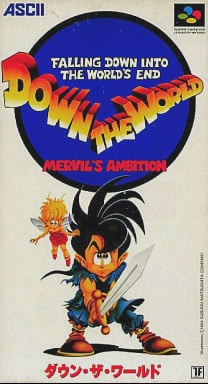
Down the World: Mervil's Ambition is a role-playing video game (RPG) developed and published by ASCII Corporation for the Super Famicom. The plot follows the knight Gao, tasked with accompanying a hero in rescuing an ailing princess and preventing the end of all life.

















